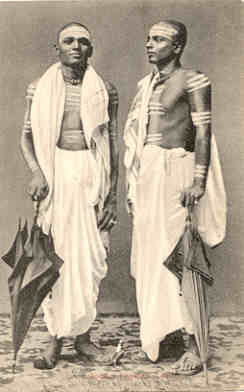Nagarathar
 | |
| Regions with significant populations | |
|---|---|
| India: Chettinad region of Tamil Nadu, Chennai | |
| Languages | |
| Tamil | |
| Religion | |
| Shaivism, Shaiva Siddhanta | |
| Related ethnic groups | |
| Tamil people, Dravidian people, Vaishya |
The Nagarathar (also known as Nattukkottai Chettiar) is a Tamil community that follows the belief system of Shaivism.
The Nagarathar or Nattukkottai Chettiar were historically an itinerant community of merchants but claim Chettinad as their traditional home. How they reached that place, which at the time comprised adjacent parts of the ancient states of Pudukkottai, Ramnad and Sivagangai, is uncertain, with various communal legends being recorded. Among those are a fairly recently recorded claim that they were driven there because of persecution by a Chola king and an older one, recounted to Edgar Thurston, that they were encouraged to go there by a Pandyan king who wanted to take advantage of their trading skills. The legends converge in saying that they obtained the use of nine temples, with each representing one exogamous part of the community.[1]
They may have become maritime traders as far back as the 8th century CE, although this is not universally accepted. Certainly, they were trading in salt by the 17th century and European expansionism in South East Asia during the next century fostered conditions that enabled the community to expand its trading enterprises, including as moneylenders, thereafter.[1]
In the 19th century, following the Permanent Settlement, some in the Nagarathar community wielded considerable influence in the affairs of the zamindar (landowners) elite. There had traditionally been a relationship between royalty and the community based on the premise that providing worthy service to royalty would result in the granting of high honours but this changed as the landowners increasingly needed to borrow money from the community in order to fight legal battles designed to retain their property and powers. Nagarathars provided that money as mortgaged loans but by the middle of the century they were becoming far less tolerant of any defaults and were insisting that failure to pay as arranged would result in the mortgaged properties being forfeited.[2] Bramhins consider them as Vaishyas and perform their day to day rituals as per bramhinical customs for a fee.
The community is listed as Other Backward Caste by the government of Tamil Nadu.
References
Citations
- 1 2 Price (1996), p. 13
- ↑ Price (1996), pp. 103-104
Bibliography
- Price, Pamela G. (1996), Kingship and Political Practice in Colonial India (Reprinted ed.), Cambridge University Press, ISBN 978-0-52155-247-9
Further reading
- Rajeswary Brown. (1993). Chettiar capital and Southeast Asian credit networks in the inter-war period. In G. Austin and K. Sugihara, eds. Local Suppliers of Credit in the Third World, 1750-1960. New York: St. Martin's Press.
- David Rudner. (1989). "Banker's Trust and the culture of banking among the Nattukottai Chettiars of colonial South India". Modern Asian Studies 23(3), 417-458.
- David West Rudner. (1994). "Caste and Capitalism in Colonial India: The Nattukottai Chettiars". University of California Press.
- Heiko Schrader. (1996). "Chettiar finance in Colonial Asia". Zeitschrift fur Ethnologie 121, 101-126.
- Nishimura, Yuko Gender. (1998). Kinship and Property Rights: Nagarathar Womanhood in South India. Oxford University Press. ISBN 0-19-564273-2.
| Wikimedia Commons has media related to Nagarathar. |